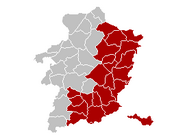| Main | Births etc |
|---|
| ||||||||||||||
| Limburg (Dutch: Limburg) |
|||
|---|---|---|---|
| — Province of Belgium — | |||
|
|||
| Country | |||
| Region | |||
| Capital | Hasselt | ||
| Government | |||
| • Governor | Herman Reynders | ||
| Area | |||
| • Total | 2,414 km2 (932 sq mi) | ||
| Population (1 January 2012)[1] | |||
| • Total | 849,404 | ||
| • Density | 350/km2 (910/sq mi) | ||
| Website | Official site | ||

View of the Great Market place in Limburg's capital Hasselt

Main Market Square of Sint-Truiden with Town Hall and Church.

Tongeren (Perron)
Limburg (Dutch pronunciation: [ˈlɪm.bʏrç]) is the easternmost of the five provinces of modern Flanders, which is one of the three main political and cultural sub-divisions of modern Belgium (Europe).
Limburg is located west of the river Meuse (Dutch Maas), upon which it borders the similarly named Dutch province Limburg. It also borders on the Wallonian province of Liège to the south, with which it also has historical ties. To the north and west are the old territories of the Duchy of Brabant, the Flemish provinces of Flemish Brabant and Antwerp to the west, and the Dutch province of North Brabant to the north.
The province of Limburg takes up an area of 2,414 km² which is divided into three arrondissements (arrondissementen in Dutch) containing 44 municipalities. Among these municipalities are the current capital Hasselt, the early medieval capital Borgloon, Genk, Diepenbeek (home to Hasselt University), and Tongeren, the only Roman city in the province and regarded as the oldest city of Belgium.
The municipality of Voeren is geographically detached from Limburg and the rest of Flanders, with the Netherlands to the north and the Walloon province of Liège to the south. This municipality was established by the municipal reform of 1977 and on 1 January 2008 with its six villages had a total population of 4,207. Its total area is 50.63 km².
Belgian province names fit in the "county" field in Familypedia forms.
The province's name[]
Belgian Limburg was not called "Limburg" until the 19th century, when this province, like the rest of Belgium, was part of Holland for some decades, after the fall of Napoleon. Like the name Belgium itself (also given in this time), the name Limburg was chosen from the region's history; it is derived from a medieval Duchy in the general region. Before this time, the region had been called Loon, (apart from a short period when it was part of France and referred to as part of the Department of the Lower Meuse). However the medieval Duchy of Limburg, although it was nearby, did not contain Loon.
Language[]

A map showing the areas which speak different types of Limburgish.
As in all Flemish provinces, the official language is Dutch, but two municipalities, Herstappe and Voeren, are to a certain extent allowed to use French to communicate with their citizens. Such municipalities are called the municipalities with language facilities in Belgium.
Several variations of Limburgish are also still actively used, these being a diverse group of dialects which share features in common with both German and Dutch. Limburg mijn Vaderland is the official anthem of both Belgian and Dutch Limburg, and has versions in various dialects of Limburgish, varying from accents closer to standard Dutch in the west, to more distinctive dialects near the Maas. Outside of the two Limburgs related dialects or languages are found stretched out towards the nearby Ruhr valley region of Germany. And there are also related dialects around Aachen in Germany as well as in the extreme northeast of the mainly French-speaking province of Liège.
As in the rest of Flanders a high level of multi-lingualism is found in the population.
Limburg is close to Germany and Wallonia, and because of the natural political, cultural and economics links, French and German have long been important second languages in the area.
English has also now become a language which is widely understood and used in business and cultural activities, and is supplanting French in this regard.
Veldeke, the medieval property of the family of Hendrik van Veldeke, was near Hasselt, along the Demer river, to the west of Kuringen. He is one of the first authors known by name in both Dutch and German.
Geography[]

The Demer river in the hilly "Haspengouw" area.
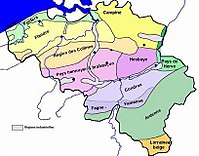
The natural regions of Belgium, with their French names (which are also often used in older English language sources.) Belgian Limburg combines large parts of the Campine and Hesbaye regions.

The Maas or Meuse river
The centre of Belgian Limburg is crossed east to west by the Demer river and the Albert Canal, which run similar paths. The Demer river's drainage basin covers most of the central and southern part of the province, except for the southeastern corner, where the Jeker (in French: (le) Geer) runs past Tongeren and into the river Maas (in French: (la) Meuse) at Maastricht.
The eastern border of the province corresponds to the western bank of the Maas, which originates in France. It's drainage basin includes not only the Jeker but most of the northern part of Belgian Limburg.
The south of the province is the northern part of the Hesbaye region (in Dutch: Haspengouw), with fertile soils, farming and fruit-growing, and historically the higher population density. The hilliness increases in the southeast, including the detached Voeren part of Limburg.
North of the Demer river and the Albert Canal is part of the Campine (in Dutch: (de) Kempen) region, with sandy soils, heathlands, and forests. This area was relatively low populated, until coal-mining started in the 19th century, attracting immigration from other areas, including Mediterranean countries.
History[]
Prehistoric[]
In Holocene times, after the ice ages, Belgian Limburg settled into a pattern of de-population followed by new populations entering the area from the north and south, making Belgian Limburg a contact zone. This was repeated several times, most recently at the end of the Roman era, when the Germanic Franks settled in the de-populated north, leaving a more Romanized population in the south, and thus the modern language border between Dutch and French is an artifact of such contacts.
The more fertile, southern Haspengouw part of Limburg, lying upon what is today the Germanic-Romance language border, has generally had more sedentary and materially wealthy inhabitants, apparently arriving in waves from the south and east. The first of these was the LBK culture which originated in central Europe and reached a geographical limit in Haspengouw, only to die out. A later example is the Michelsburg culture which also eventually disappeared.
The northern Kempen part was inhabited by more mobile tribes with links to the north and east. For example the Swifterbant culture were contemporaries of the LBK culture, and appear to have traded with them, and possibly to have come into conflict with them.
The scene was set for the historical period with the arrival in the area of the Urnfield culture, followed by the possibly related Halstatt and La Tène cultures. Under these cultures the population increased, and it is probably also during this period that Indo European languages arrived.
Celts, Germani and Romans[]

Statue of Ambiorix in the main square of Tongeren.

Still in use: the Roman paved road between Tongeren and Tienen
Before the Romans, Belgian Limburg was home to the tribal grouping known from Caesar as the Germani cisrhenani. While there is some doubt about the exact positions of the tribes within this group, Belgian Limburg is generally considered to have been contained with the country of the Eburones who fought against Julius Caesar under their leaders Ambiorix and Cativolcus. Also living in the general area (although perhaps not in Limburg) were the Aduatuci, who were the descendants of the Cimbri and Teutones who had settled from Denmark some generations before Caesar.
The Eburone fort was called Aduatuca. This was possibly a general word for a fort, associated not only with the Eburones, but also the Aduatuci, and the Tungri. The Roman city established in Belgian Limburg was referred to as Aduatuca Tungrorum meaning "Aduatuca of the Tungri". Today this has become "Tongeren", in the southeast of Belgian Limburg, and it was the capital of a Roman administrative region called the "Civitas Tungrorum". Under the Romans, the Tungri civitas was first a part of Gallia Belgica, and later split out with the more militarized border regions between it and the Rhine, to become Germania Inferior, and still later it became part of Germania Secunda.[2]
Tacitus equated these Tungri to the earliest tribes of "Germani" to have settled in Gaul, implying that they were substantially still descended from the Germani cisrhenani, and also states that this name had been spread to cover a grouping of different tribes, for example those in Germany. The Tungri are generally accepted as being speakers of a Germanic language, but modern authors disagree over the extent to which they descend from new immigrants who came from over the Rhine after Caesar. Notably, the Tungri participated in the Revolt of the Batavi against the Romans.[3]
Middle Ages[]
In late Roman and early medieval times, the northern or "Kempen" part of Belgian Limburg became a more separate area, referred to as Toxandria. It became virtually empty because of Germanic plundering, and was then settled and ruled by incoming Salian Franks from Germany. The southern or "Haspengouw" part of Belgian Limburg remained more heavily Romanised, but eventually became a core land of the Frankish empires. It was from here that Chlodio, in the 5th century, launched the Franks into military campaigns of conquest into northern Gaul, soon to become Merovingian France or "Francia", the country of the Franks. By the 9th century, the Frankish Carolingian dynasty, based in and around Belgian Limburg, ruled an empire that included not only the region of Belgium and northern France, but also eventually much of Western Europe.
Under the Franks, the region begins to be referred to with new placenames, which last into the Middle Ages and in some cases into modern times. The northern Kempen was still referred to as Toxandria. The southern part, received its modern name of Haspengouw, found in forms such as Haspinga, pagus Hasbaniensis or Hasbania, in old documents such as the Treaty of Meersen.
Early Christianity was also established earliest in this romanised southeastern corner of Limburg, around Tongeren. Together with nearby Maastricht and Liège, this was the area of activity of St Servatius and later Lambert of Maastricht. Another early saint in the south of Limburg was St Trudo.
After the death of Charlemagne, Limburg was part of the Lotharingian division of frankish Europe which lay between France and Germany and stretched to Italy. After the death of its first ruler, Lothar, it was only slowly integrated into Eastern Francia, which was to become the Holy Roman empire. In the period around 881 and 882 the areas along the Maas and in the Haspengouw were plundered by Normans, who established a base at Asselt on the Maas, today in Roermond in Dutch Limburg. Belgian Limburg corresponds closely to the medieval territory of the County of Loon (French Looz), which originally centred on the fortified town of Borgloon, which became the centre of power in the Haspengouw during the early Middle Ages. Borgloon came to possess most of Haspengouw, and also the large part of the Kempen which the province contains today. As part of Loon, Belgian Limburg eventually became subject, not only spiritually but also politically, to the Prince Bishops of Liège.
Modern history[]

A monument in Hasselt to the "boerenkrijgers", peasants who revolted against the absorption of Belgium into revolutionary France, and lost

Winterslag remains of Limburg's coalmining past, that ended in the twentieth century
Loon, and the rest of the prince-bishopric of Liège, were not joined politically with the rest of what would become Belgium until the French revolution. Nevertheless, in the 16th, 17th, and 18th centuries the population of Loon was constantly and badly affected by the wars involving neighbouring Brabant and Dutch Limburg, including the Eighty Years' War, the War of the Spanish Succession, the War of the Austrian Succession, the Seven Years War, and even the Brabant Revolution against the unpopular reforms of the Emperor Joseph II. During this period the region's episcopal government was often unable to maintain law and order, and the economy of the area was often desperately bad, affected by plundering by soldiers and gangs of thieves such as the "Bokkenrijders". Nevertheless the population contained strongly conservative catholic elements, and not only supported the conservative Brabant revolution, but also rebelled unsuccessfully against the revolutionary French regime in the Peasants' War of 1798.
The modern Limburg region, containing the Belgian and Dutch provinces of that name, were first united within one province while under the power of revolutionary France, and later the Napoleonic empire, but then under the name of the French department of the Lower Meuse (Maas). The first king, William I, insisted that the name be changed to the "Province of Limburg", based on the name of the medieval Duchy of Limburg. It is only in border areas near Maastricht, for example in Voeren, that either of the two modern Limburgs have any strong historical connection to the old Duchy. One small part of Belgian Limburg was really in the Duchy of Limburg: in the extreme east of Voeren, the villages of Teuven and Remersdaal. After the Belgian Revolution of 1830, the province of Limburg was at first almost entirely under Belgian rule, and the status of both Limburg and Luxembourg became unclear. During the "Ten days campaign", 2–12 August 1831, Dutch armies entered Belgium and took control of several Belgian cities in order to negotiate from a stronger position. Several Belgian militias and armies were easily defeated including the Belgian Army of the Meuse near Hasselt, on 8 August. The French and British intervened, leading to a ceasefire, and in 1831 the Treaty of London established that both Limburg and Luxemburg would be split between the two states. Finally, in 1839 Limburg and Luxemburg were split, Limburg being split into so-called Dutch Limburg and Belgian Limburg.
Twentieth century[]
Belgian Limburg became officially Flemish when Belgium was divided into language areas in 1962. In the case of Voeren, surrounded by French speaking parts of Belgium, and having a significant population of French speakers, this was not without controversy.
Only in 1967, the Catholic Church created a bishopric of Hasselt, separate form the bishopric of Liège.
Administrative divisions[]
Arrondissements[]
 Arrondissement Hasselt |
 Arrondissement Maaseik |
 Arrondissement Tongeren |
Communes ("Gemeenten")[]
|
Arrondissement Hasselt: |
Arrondissement Maaseik: |
Arrondissement Tongeren: |
Judicial cantons[]
Governors since the second world war[]
The first governor of united Limburg (including the province of Limburg in the Netherlands) was Charles de Brouckère, from 1815, after the Battle of Waterloo until 1828. He was followed by Maximilien de Beeckman who governed the united province until 1830, when the Belgian revolution began and division of Limburg began, first with the separation of Maastricht. The splitting of Dutch and Belgian Limburg was completed by 1839.
There were also breaks in the sequence of governors in the first world war and at the end of the second world war. The following list contains all governors of the province of Limburg since the second world war.[4]
- Herman Reynders, governor of Limburg from 5 October 2009 until present (°1958)
- Steve Stevaert, governor of Limburg from 1 June 2005 until 15 June 2009 (° 1954)
- Hilde Houben-Bertrand, governor of Limburg from 1995 until 2005 (° 1940)
- Harry Vandermeulen, governor of the king from 1978 until 1995 (°1928)
- Louis Roppe, governor of the king from 1950 until 1978 (°1914 - +1982)
Towns in Limburg[]
Bilzen, Borgloon, Genk, Hasselt, Maaseik, Sint-Truiden, Tongeren
 Bilzen (Townhal) |
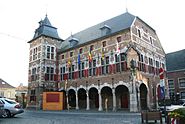 Borgloon (Townhal) |
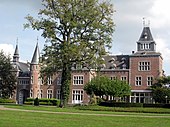 Genk (Bokrijk Castle) |
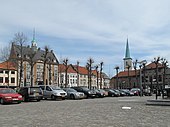 Maaseik (Central square) |
Economy[]

Map of the Meuse-Rhine Euregion with the Region of Aachen shown in red, the southern part of Dutch Limburg in blue, Belgian Limburg in lightgreen, the Province of Liège in mid-green and the German-speaking Community of Belgium in dark-green

Cherries, an important product of Limburgian fruit growing business.
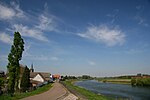
Biking along the Meuse rivier; (here at Lanaken)
In the economic field tourism is being actively promoted with publicized attractions including Limburg's claim to be a "Bicycle Paradise" (Fietsparadijs). There's also the possibility to walk in nature reserves, such as the "High Kempen National Park".[5][6]
In the south, the Haspengouw (Hesbaye), predominantly situated in Limburg, is now Belgium's major area for fruit growing. In Limburg more than 50% of Belgium's fruit production is grown. Of the rest about 40% is grown in other Dutch speaking provinces.
Coal mining has been an important industry in the 19th century, but has now ended in this province. Nevertheless it has laid the basis for a more complex modern economy and community. In the 20th century, Limburg became a centre for secondary industry, attracting Ford, who still have a major production centre in Genk, though this is scheduled to be closed, and the electronics company Philips, who had a major operation in Kiewit.
Many areas such as Genk continue to have a lot of heavy and chemical industry, but emphasis has moved towards encouraging innovation. The old Philips plant is now the cite of a Research Campus, and the Hasselt University in Diepenbeek has a science park attached to it.
The region today promotes itself as a centre for trade in the heart of industrialised Europe. It is part of the Meuse-Rhine Euroregion, which represents a partnership between this province and neighbouring provinces in Germany, the Netherlands and Wallonia.
Culture[]
Essential elements in Limburgian culture are:
- Music (most places have their own brass-band; From 1965 until 1981 yearly an internationally known jazz- en rockfestival took place at Bilzen, before it moved outside of Limburg to Werchter, where it's still held, by now as "Rock Werchter"). Another well known yearly music festival is Pukkelpop in Hasselt.
- Religion (predominantly Roman Catholic)
- Folklore (For instance several places still have a now folkloristic "citizen force"),
- Carnival
- Sports, of which especially bicycle racing and soccer are most popular. Professional soccer clubs playing in the three highest national divisions are: K.R.C. Genk (Division 1), Lommel United and K. Sint-Truidense V.V. (Division 2); K. Patro Eisden Maasmechelen and KSK Hasselt (Division 3). K.R.C. Genk have won the national championship three times. Motocross is also popular, with four former world champions in this sport coming from Belgian Limburg; together they won 20 world championships.
 Bicycle racing |
 Pukkelpop music festival |
 Religion and folklore: Processions |
Famous Limburgians[]
|
|
Sports & Entertainment
|
|
Sights[]
- Bokrijk open air museum near Genk.
- High Kempen National Park.
- Racing circuit Terlaemen in Zolder, where apart from many Formula One and other car races also two world championships in bicycle racing have been held.
- A considerable number of castles and other historic properties[7]
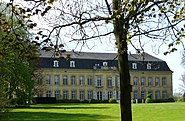 The Abbey of Hocht at Lanaken |
 Royal Atheneum Hasselt |
 Altembrouck castle at Gravenvoeren |
 Duras castle Sint-Truiden |
Nature of Limburg (Gallery)[]
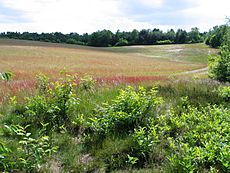 Teut nature reservation |
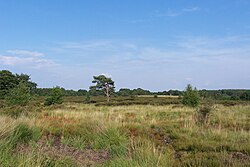 Mechelse Hei (Maasmechelen Heath) |
 Maasvallei (Meuse valley) |
See also[]
- Limburgish language
- List of Governors of Limburg, Belgium
- Limburg (Netherlands), a province in southeastern Netherlands.
- Hesbaye
- CIPAL
- Campine
- Limburg Science Park
References[]
- ^ Population per municipality on 1 January 2012 (XLS; 214 KB)
- ^ Wightman (1985:202)
- ^ Wightman (1985:104)
- ^ (Dutch) Gouverneurs van 1815 tot nu, limburg.be
- ^ Tourism Limburg website
- ^ National Park "Hoge Kempen" website
- ^ "List of castles in Limburg" on NlWp
Other sources[]
- Jappe Alberts (1974), Gecheidenis van de Beide Limburgen, Van Gorcum
- Wightman, Edith Mary (1985), Gallia Belgica, University of California Press, http://books.google.com/books?id=aEyS54uSj88C
External links[]
- (Dutch) Official website
| ||||||||||||||||||||||||||||||
| This page uses content from the English language Wikipedia. The original content was at Limburg (Belgium). The list of authors can be seen in the page history. As with this Familypedia wiki, the content of Wikipedia is available under the Creative Commons License. |





